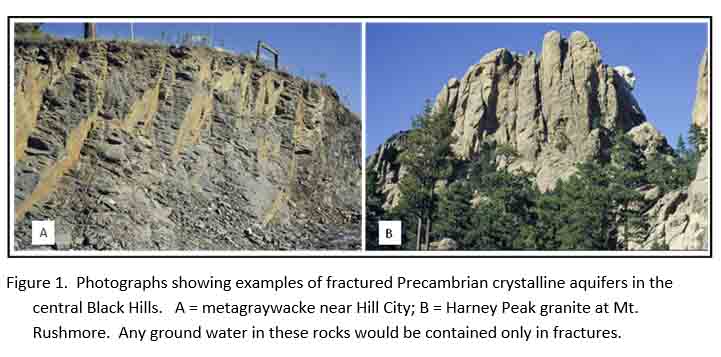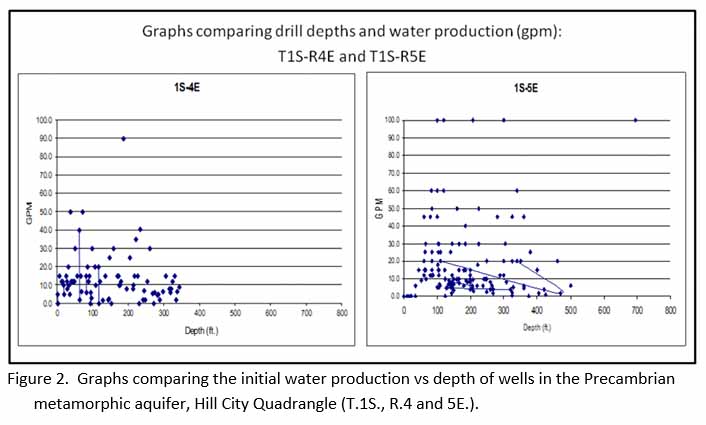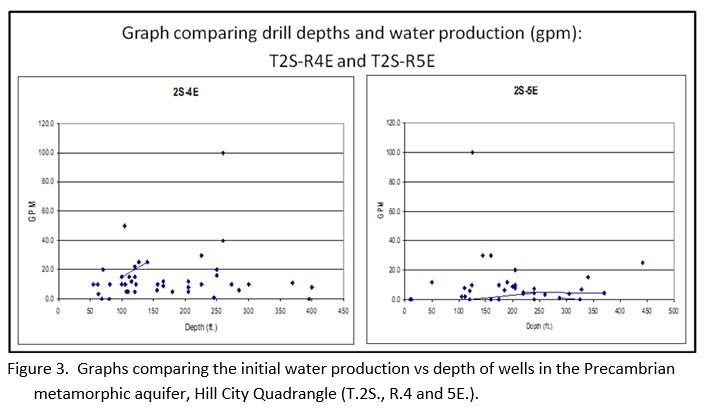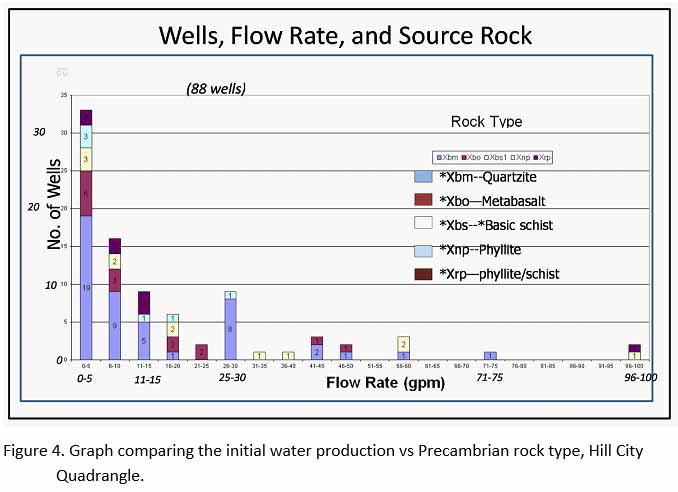Ground-Water Quantity
Water Quantity in Precambrian
Crystalline Rocks:
Introduction
When one is considering the expense of drilling a water well several questions are appropriate to consider. These include how deep will I have to drill, how much water will I be able to expect from the well, and what will be the quality of that water.
In the case of sedimentary aquifers,answers to these questions can be given in general terms based upon what is known of the specific formation/aquifer in the immediate area.
In contrast, for the Precambrian crystalline aquifersin the central portion of the Black Hills, the quantity of water is generally less than that of the sedimentary aquifers and some wells may not produce water at all, even though others near-by do so.
The following section provides information regarding water quantity in crystalline aquifers in the central mountainous portion of Pennington County. Information regarding water quality is given separately in the section “Pennington County Aquifers – Water Quality”.
Location of Study
The information given below for the Precambrian crystalline aquifers is taken from wells drilled in the Hill City area in Townships one and two South, Ranges four and five East. This area of about 55 square miles comprises the Hill City
quadrangle (see location map). The characteristics of the rocks present here are similar to those found in other areas of metamorphic or igneous rocks in the core of the Black Hills. Therefore, these values for depth and water production rates are likely representative of the other areas as well.
Source of information
South Dakota state regulations require that descriptive values about all new water wells be reported to the Department of Environment and Natural Resources. Information contained in the following section utilized these reports to prepare tables/graphs containing:
Initial water production rate
Depth of well
Well
location
Based upon the location given in the DENR reports, the particular rock formation (type) drilled at that site was determined from 1:24,000-scale (1inch = 2,000 feet) geologic quadrangle maps published online by the South Dakota Geological Survey.
Results
Precambrian aquifers: Depth and volume of water
Crystalline rocks of the central Black Hills contain water only within fractures, e.g., those shown in the metagraywacke and granite of Figures 1A and B. As evident there, such fractures are commonly vertical and are spaced several inches to many feet apart. Therefore, the depth needed to drill in order
to encounter sufficient water-filled cracks to produce a well is very difficult to predict, and involves a substantial proportion of luck. If the well should be sited directly on a larger fracture, sufficient water may be encountered near the surface. In other cases, it is possible drill several
hundred feet with little or no success.

As shown in Figures 2 and 3, the results of drilling in the fractured aquifers of the Hill City area are highly variable. For those drilled in Township 1 South, few wells showed an initial production of more than 60 gallons per minute and most were less than 20 gallons per minute. For the five wells with an initial production
of 100 gallons per minute, depths ranged from 100 feet to more than 700 feet.
Wells drilled in Township 2 South (south and southeast of Hill City) show even lower initial production rates (Figure 3). Very few have greater than 20 gallons per minute and most are less than 10. This includes wells drilled to depths of over
400 feet. For many of these wells the drilling records do not note the actual depths at which water was encountered. Therefore, it is not clear that water production was increased by drilling deeper in each case.


Precambrian aquifers: Rock type
and volume of water
Possibly, the type of crystalline rock which a well penetrates may affect the degree to which the rock fractures and, therefore, the quantity of water which it may hold across a given distance. As an example, shattered quartz veins within the various rock types are commonly
noted in wells logs as producing water. Figure 4 is a graph comparing the initial volume of water produced in new wells with the type of rock encountered there. The depth of the wells and, therefore, the length of rock from which the water was produced, are not considered in this graph.

As noted in the previous section, Figure 5 also indicates that initial production rates are generally less than 30 gallons per minute and more than one-half are 12 gallons per minute or less. Of the 88 wells noted, the majority are in metagraywacke.
Metagraywacke 47
Metabasalt 15
Basic schist 11
Phyllite 6
Phyllite/schist 8
These numbers are too few to allow a statistical comparison, but the relationships shown on the graph suggest no recognizable difference in production of water dependent upon the type of fractured rock, at least for this area.